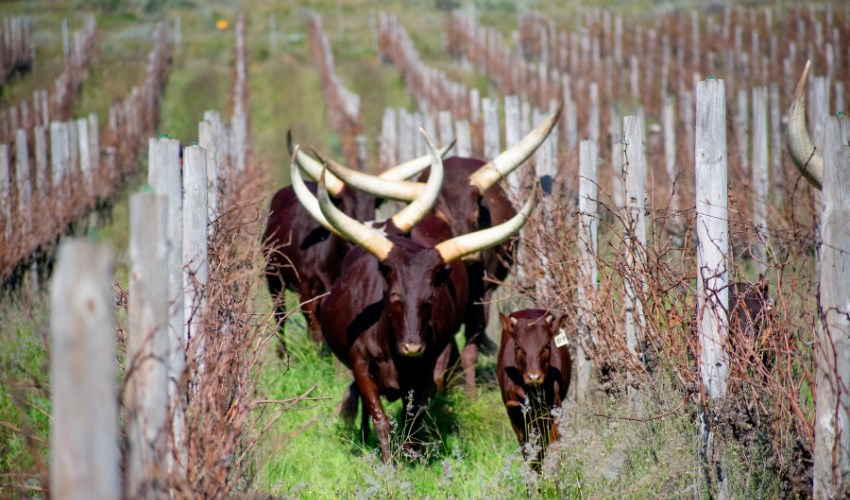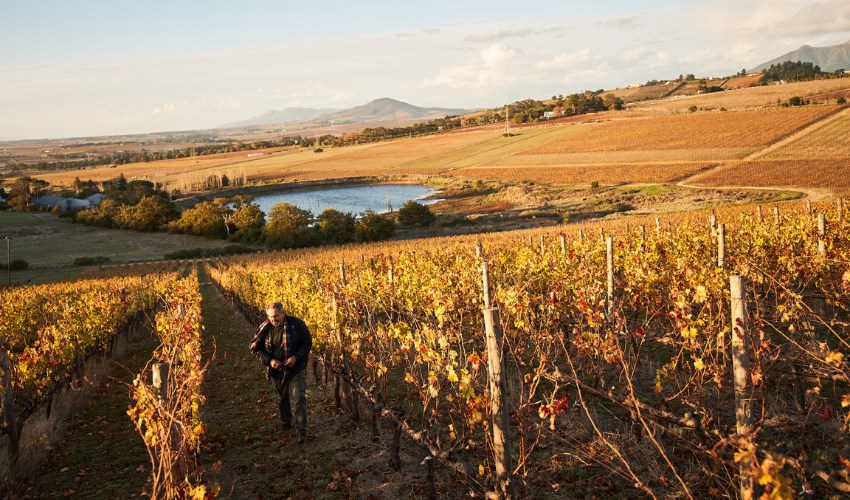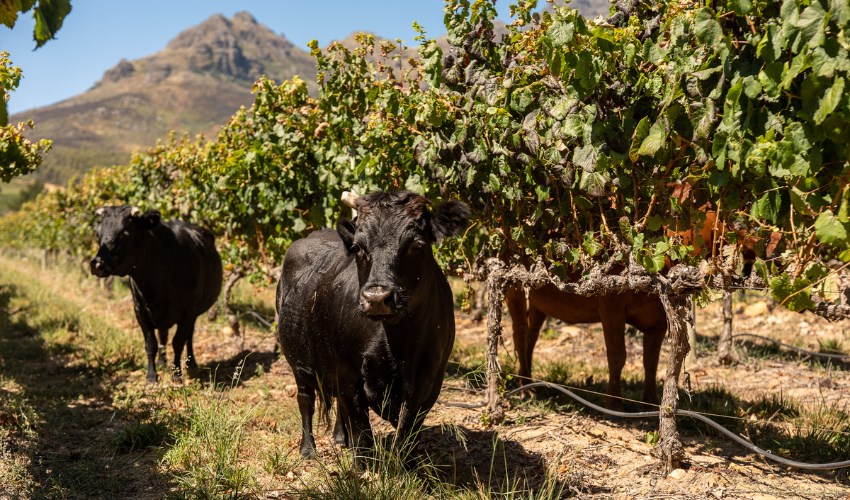
Ankole cattle in the vineyard at Hartenberg Estate, Stellenbosch.
The last of the secateurs are packed away, ferments bubble, the South African 2023 harvest has come and gone, and now the vineyards are at rest. Slumbering upright in their cold soils all may seem quiet above, but underground is a hive of activity. Like an upside tree roots twist through the earth channelling energy into preparing for the next growth cycle. Around the tributaries branching off deeper into the loam, the granite, the slate – hums a universe of microbes, nourishing the soils that keep the vine healthy from root to tip.
New Zealand wine grower James Millton said it best: "We are not standing on dirt, but on the rooftop of another kingdom."
“Soil is the bedrock for healthy water, nutrients, and carbon cycling,” remarks Carl Schultz, cellarmaster of Hartenberg. “This is clear to us from the healthier crops, increased yields and vibrant microbial communities on our farm.”
Newly minted as a WWF Conservation Champion the Stellenbosch estate has long been ahead of the regenerative agriculture curve.
A seemingly new term with ancient roots, soil health is at the heart of the discipline, which aims to build the resiliency of the ecosystem. Some of the core practices include: minimising soil disturbance, maximising crop diversity, eliminating bare soils, encouraging living roots, and integrating livestock or animals.
Animals in vineyards? Long has the ideology been taught in agricultural institutions that grazing livestock can cause compaction of the soil. “This can be true, sure,” says Schultz. “But only if you don’t move them.
“Our forefathers all did mixed farming, it was just what was done then,” continues Schultz. “The core idea of working with nature, and not against it, has been around for millennia.
“Farm animals have always been crucial to the success of regenerative agriculture. It was only when we commercialised farming in the ‘70s and started using chemicals that we lost the art. This way of farming is a rediscovery of what is possible.”
Way back in 1995 Hartenberg implemented a decade-long project to remove alien vegetation from its 65-hectare wetland area. This cleared space for the return of indigenous flora and fauna, and has increased soil water levels as well as longer run-offs after rain.

Carl Schultz walking through the vineyard at Hartenberg.
“The dung beetle returned,” enthuses viticulturist Wilhelm Joubert joining the conversation. Joubert is the quiet hero behind the reintegration of livestock into the vineyards.
In 2017 Joubert headed the project to introduce a herd of cattle into the system. This was initially done to regenerate soils in fallow areas, whereby crops would be sewn for grazing fodder. Joubert discovered it was also beneficial to have grazers in the actual vineyard.
“The treading of the hooves, the pulling effect from grazing, as well as the saliva, manure, and urine all improve soil health,” he elaborates.
Above ground are ladybirds and two indigenous wasp species employed as the vanguard against leafroll virus. The insects have an appetite for mealybugs, the vector of the disease. This simple, effective method has kept Hartenberg’s vineyard virus free for the last 18 years. No need to spray here, which would have a deleterious effect on the soils. The nightwatch belongs to different wings. Twelve breeding pairs of barn owls (and some free-range eagle owls) swoop in at night to keep the rodent population under control, which like to nibble on shoots and roots of vines as well as cover crop seeds.
“When improving the microclimate, it also has a positive effect on the wine we make,” remarks Joubert.
The proof is in the pH. “We’re already seeing positive results.”
“The analyses are incredible,” jumps in Schultz. “We can see clear differences between sites.” He explains that the parcel that saw grazing has a lower pH, better retention of the natural acidity, and the grapes also reached an optimal ripeness at a Balling lower.
“Climate change is the slow poison of our time,” Schultz furthers the discussion. “We know we’re heading into a future of water scarcity. The best defence is carbon-rich soils.
“We noticed a real uptick in carbon sequestration since we’ve introduced animals in the mix.”
Walking on the rooftop
“The soils seem softer to walk on, richer in organic matter as well as bugs and worms are more common,” enthuses Mark le Roux, cellarmaster of Waterford. “The vineyards also seem more resistant to disease. The recent 2023 vintage presented high pressures, and we experienced a low incidence.”
A relative newcomer to regenerative agriculture the Stellenbosch estate has been practicing for the past 18 months, making the switch from sustainable farming. Like Hartenberg, they have discovered that grazing cattle is crucial for their aims.
The use of livestock Le Roux highlights has another use. “Animals big and small play a vital role in soil health,” he emphasises. “The larger animals like our miniature Dexter cows control weeds by grazing in the vineyards. Weeds compete with vines for nutrients and water. By eliminating them it allows for better airflow. In particular around the lower bunch zone, which reduces the chances of mildews and rot.”

Miniature Dexter cows between the vines at Waterford Wine Estate, Stellenbosch.
Of Waterford’s 120 hectares, only 50 are under vine. The remaining have been given over to preserving local fauna and flora, which as we know has an impact on water levels in the soil among other benefits.
On the role of small animals, Le Roux says “...our geese control the snails. Snails can cause quite a bit of damage to vine growth points, buds as well as feed on young leaves.” Owls are on rodent patrol here too.
“The animals also actually help with soil compaction as they reduce tractor traffic within the vineyards.”
And even smaller, much smaller Le Roux says, “...the tiny organisms in the soil itself. Nematodes, earthworms and millipedes all assist in decomposing and nutrient cycling as well as with aeration and water channels within the soil.”
While it is still early days for Waterford in assessing how wine quality benefits from this style of farming, Le Roux is convinced it will. “A vine in a good stable condition will most definitely provide grapes of superior quality.”
They have brought soil even further into their winemaking ethos. Under each row in the barrel cellar, a part of the earth is exposed, which is said to help regulate temperature and humidity levels.
“South Africa has some of the oldest soils in the world,” points out Le Roux. “This alone should make our wines and diversity found here something special. Waterford is looking at preserving and enriching this legacy and showing it in our wines.”

Vineyards at Waterford Wine Estate.
Choose wines for your palate and the planet. Shop our selection of WWF Conservation Champion wines HERE and give back to the planet.